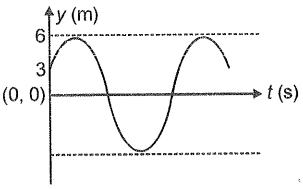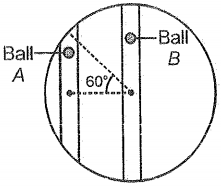The x-t graph of a particle undergoing SHM is shown below. The acceleration of the particle at is:

1.
2.
3.
4.

The position-time (y - t) graph of a particle executing S.H.M. is shown. The time period of the particle is 4 seconds. Equation of particle executing S.H.M. is

1.
2.
3.
4.
A particle starts executing SHM from an extreme position with time period T and amplitude A. The distance travelled by the particle in time is:
1. 3.5 A
2. 2.5 A
3. 0.5 A
4. 1.5
Two tunnels are dug across the earth as shown in the figure. Balls A and B are dropped in the tunnels. If the time period of oscillation of ball A is T, the time period of the oscillation of ball B is :

1. T
2.
3.
4.
Select the correct statement(s) regarding S.H.M.
1. The average speed of particle executing S.H.M. is zero in one complete oscillation.
2. The graph between the kinetic and potential energy of a particle executing S.H.M. is a straight line.
3. Restoring force acting on the particle is directed towards a fixed point and is directly proportional to the displacement from the mean position of the particle.
4. Both (2) & (3)
The graph between the velocity \((v)\) of a particle executing SHM and its displacement \((x)\) is shown in the figure. The time period of oscillation for this SHM will be:
1. \(\sqrt{\frac{\alpha}{\beta}}\)
2. \(2\pi\sqrt{\frac{\alpha}{\beta}}\)
3. \(2\pi\left(\frac{\beta}{\alpha}\right)\)
4. \(2\pi\left(\frac{\alpha}{\beta}\right)\)
The displacement of a body performing simple harmonic motion is represented by . After what approximate time from t = 0, the speed of the particle becomes maximum for the first time?
1. 0.12 s
2. 0.24 s
3. 0.33 s
4. 0.42 s
A particle is performing S.H.M. with a time period 8 s and starts from the origin. The ratio of distance travelled by a particle in 1st second and 2nd second of its motion is :
1.
2. ( + 1)
3. ( - 1)
4. 2
Two particles are executing SHM about the same mean position, along the same straight line, with the same amplitude and time period. At any instant, they meet each other at, \(\frac{-A}{2}\) while moving in the opposite direction. The phase difference between them is:
1. \(\frac{2\pi}{3}\)
2. \(\frac{\pi}{3}\)
3. \(\frac{11\pi}{6}\)
4. \(\frac{7\pi}{6}\)
A small block of mass m is kept on a wooden plank which is oscillating in the vertical plane (as shown), with time period T. The amplitude of oscillation at which block leaves contact with the plank is

1.
2.
3.
4.







